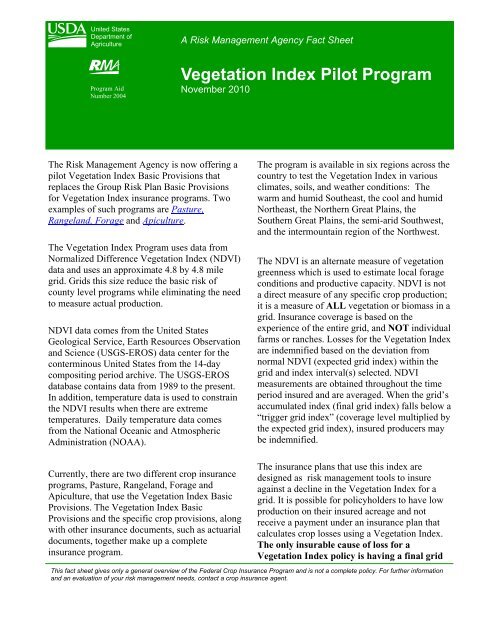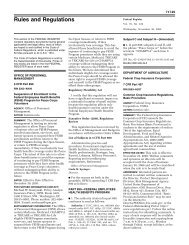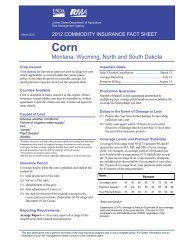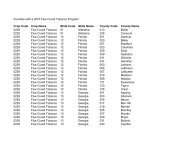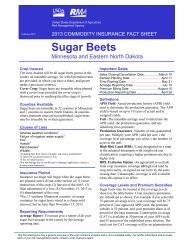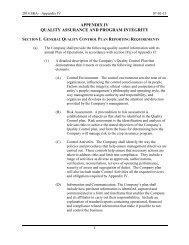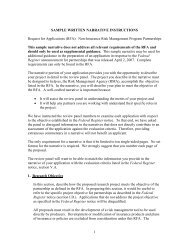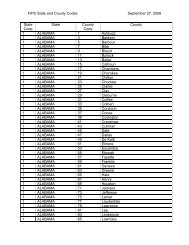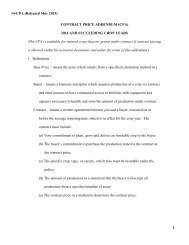Vegetation Index - RMA USDA Risk Management Agency - US ...
Vegetation Index - RMA USDA Risk Management Agency - US ...
Vegetation Index - RMA USDA Risk Management Agency - US ...
Create successful ePaper yourself
Turn your PDF publications into a flip-book with our unique Google optimized e-Paper software.
United StatesDepartment ofAgricultureProgram AidNumber 2004A <strong>Risk</strong> <strong>Management</strong> <strong>Agency</strong> Fact Sheet<strong>Vegetation</strong> <strong>Index</strong> Pilot ProgramNovember 2010The <strong>Risk</strong> <strong>Management</strong> <strong>Agency</strong> is now offering apilot <strong>Vegetation</strong> <strong>Index</strong> Basic Provisions thatreplaces the Group <strong>Risk</strong> Plan Basic Provisionsfor <strong>Vegetation</strong> <strong>Index</strong> insurance programs. Twoexamples of such programs are Pasture,Rangeland, Forage and Apiculture.The <strong>Vegetation</strong> <strong>Index</strong> Program uses data fromNormalized Difference <strong>Vegetation</strong> <strong>Index</strong> (NDVI)data and uses an approximate 4.8 by 4.8 milegrid. Grids this size reduce the basic risk ofcounty level programs while eliminating the needto measure actual production.NDVI data comes from the United StatesGeological Service, Earth Resources Observationand Science (<strong>US</strong>GS-EROS) data center for theconterminous United States from the 14-daycompositing period archive. The <strong>US</strong>GS-EROSdatabase contains data from 1989 to the present.In addition, temperature data is used to constrainthe NDVI results when there are extremetemperatures. Daily temperature data comesfrom the National Oceanic and AtmosphericAdministration (NOAA).The program is available in six regions across thecountry to test the <strong>Vegetation</strong> <strong>Index</strong> in variousclimates, soils, and weather conditions: Thewarm and humid Southeast, the cool and humidNortheast, the Northern Great Plains, theSouthern Great Plains, the semi-arid Southwest,and the intermountain region of the Northwest.The NDVI is an alternate measure of vegetationgreenness which is used to estimate local forageconditions and productive capacity. NDVI is nota direct measure of any specific crop production;it is a measure of ALL vegetation or biomass in agrid. Insurance coverage is based on theexperience of the entire grid, and NOT individualfarms or ranches. Losses for the <strong>Vegetation</strong> <strong>Index</strong>are indemnified based on the deviation fromnormal NDVI (expected grid index) within thegrid and index interval(s) selected. NDVImeasurements are obtained throughout the timeperiod insured and are averaged. When the grid’saccumulated index (final grid index) falls below a“trigger grid index” (coverage level multiplied bythe expected grid index), insured producers maybe indemnified.Currently, there are two different crop insuranceprograms, Pasture, Rangeland, Forage andApiculture, that use the <strong>Vegetation</strong> <strong>Index</strong> BasicProvisions. The <strong>Vegetation</strong> <strong>Index</strong> BasicProvisions and the specific crop provisions, alongwith other insurance documents, such as actuarialdocuments, together make up a completeinsurance program.The insurance plans that use this index aredesigned as risk management tools to insureagainst a decline in the <strong>Vegetation</strong> <strong>Index</strong> for agrid. It is possible for policyholders to have lowproduction on their insured acreage and notreceive a payment under an insurance plan thatcalculates crop losses using a <strong>Vegetation</strong> <strong>Index</strong>.The only insurable cause of loss for a<strong>Vegetation</strong> <strong>Index</strong> policy is having a final gridThis fact sheet gives only a general overview of the Federal Crop Insurance Program and is not a complete policy. For further informationand an evaluation of your risk management needs, contact a crop insurance agent.
index less than the trigger grid index.Because the program is designed for producerswhose production and vegetation index tendsto follow the average vegetation index patternsfor the grid and not individual crop production,it is important that you review the historicalindices, additional tools, and informationprovided on the <strong>RMA</strong> Web site to determine ifthe program is suitable for you.The Pasture, Rangeland, Forage andApiculture Rainfall <strong>Index</strong> and <strong>Vegetation</strong><strong>Index</strong> pilot programs are being tested in selectcounties and States. You can view a map and alist of the counties and States where each indexis available at: http://www.rma.usda.gov/policies/pasturerangeforage, for Pasture,Rangeland, Forage or at: http://www.rma.usda.gov/policies/ri-vi/apiculture.html for Apiculture.Contact UsUnited States Department of Agriculture<strong>Risk</strong> <strong>Management</strong> <strong>Agency</strong>1400 Independence Ave., SW, Stop 0801Washington, D.C. 20250-0801TEL: (202) 690-2803FAX: (202) 690-2818Web site: http://www.rma.usda.govEmail: rma.cco@rma.usda.govDownload Copies from the WebVisit our online publications/fact sheets page at:http://www.rma.usda.gov/pubs/rme/fctsht.htmlThe U.S. Department of Agriculture (<strong><strong>US</strong>DA</strong>) prohibits discriminationin all its programs and activities on the basis of race,color, national origin, age, disability, and where applicable, sex,marital status, familial status, parental status, religion, sexualorientation, genetic information, political beliefs, reprisal, orbecause all or a part of an individual's income is derived fromany public assistance program. (Not all prohibited bases applyto all programs.) Persons with disabilities who require alternativemeans for communication of program information (Braille,large print, audiotape, etc.) should contact <strong><strong>US</strong>DA</strong>'s TARGETCenter at (202) 720-2600 (voice and TDD).To file a complaint of discrimination write to: <strong><strong>US</strong>DA</strong>, Director,Office of Civil Rights, 1400 Independence Avenue, S.W., Washington,D.C. 20250-9410 or call (800) 795-3272 (voice) or (202)720-6382 (TDD). <strong><strong>US</strong>DA</strong> is an equal opportunity provider andemployer.<strong>Risk</strong> <strong>Management</strong> <strong>Agency</strong><strong>Vegetation</strong> <strong>Index</strong>/PA-2004


